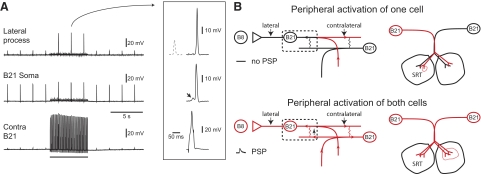FIG. 8.
A: spiking in 1 B21 can modify spike propagation in the contralateral cell. One B21 was repeatedly peripherally activated at a membrane potential that was above resting potential but was not sufficient to induce spike propagation to the lateral process. Action potentials were triggered in the contralateral cell via the injection of brief current pulses during the period of time indicated by the bar under the bottom trace. This induced coupling potentials, which are primarily observed in somatic recordings (see arrow in the middle trace in the inset). These potentials modified spike propagation. In the inset, compare the electrotonic potential shown with the dashed line (which was recorded before the activation of the contralateral neuron) to the full-size spike recorded during the period of stimulation (recording shown with the solid line). B: left: proposed model of spike propagation when only 1 B21 neuron is activated (top) and when both cells are activated (bottom). For simplicity, our discussion is focused on the region shown in the dashed box. When only 1 cell is activated (top), spikes actively propagate in the regions shown in red. Active propagation fails in the somatic region of the neuron, in part because of the fact that this region is inexcitable. When both cells are peripherally activated (bottom), the somatic region of each neuron receives additional depolarizing input in the form of coupling potentials generated by the spiking in the contralateral process of the sister neuron. This will tend to promote lateral process spike propagation and afferent transmission to B8. Right: stimulus properties will determine the pattern of B21 activation. Top: the B21 neurons have bilateral, partially overlapping receptive fields. If a stimulus is applied to a region where receptive fields do not overlap, the B21 neurons will be selectively activated (i.e., 1 cell is shown in red). Bottom: if a stimulus is applied to a region where the receptive fields overlap, both cells will be peripherally activated (i.e., both are shown in red).

